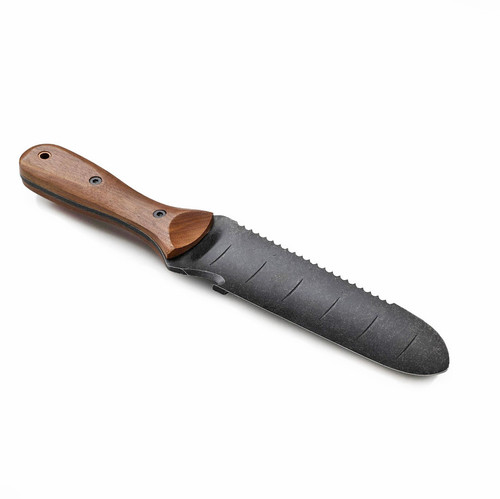
Shipping: Ships within 1 Business Day: Processing time varies: Learn more
The Compost Thermometer with a 20" stem is the perfect tool to ensure your compost is at the optimal temperature all year round!
Overview
The 20" Compost Thermometer gives a clear temperature read on your compost pile, to be sure it is reaching the desired temperature. An accurate read of the internal temperature will help you know when to turn or tumble your pile. The thermometer will also help you gauge when to add water or add more brown material. Most importantly, knowing the internal temperature will confirm when your compost is complete!
The durable stainless steel stem is 1/4" diameter. The dial reader is hermetically sealed to prevent fogging. The packaging is 100% compostable, and free of any plastics. Just shred the box to use in your compost pile as a brown matter.
Features & Benefits:
- 20" thermometer 1/4" diameter stem
- Easy to use, just push stem into your compost pile
- Fog resistant, sealed dial
- Quick temperature response
- High accuracy
- 200 degrees Fahrenheit
- Compostable packaging
- Made in the USA
Steady Zone: 80 – 100°F
The collaboration of bugs, worms and microorganisms are slowly breaking down the rich organic material in the pile. A compost pile will remain in the Steady Zone until it runs out of fuel or becomes dry. If the inner pile temperature falls to within a few degrees of the ambient air temperature, you may need to add fuel, water or turn the pile. If the material is dark brown and smells “earthy” then the compost is finished.
Active Zone: 100 – 130°F
For most backyard piles this should be the zone you try to keep your pile in for the quickest composting. In this temperature range mostly all of the composting occurs at the microorganism level. Most insects and worms cannot withstand the heat of the pile and organic material breaks down by method of small organisms.
If your pile peaks into the Active Zone, then falls back into the Steady Zone, it’s time to turn your pile. Move the material from the outside of the pile to the inside to induce further decomposition. The inside of the pile should be moderately damp.
Hot Zone: 130 – 160°F.
Only large piles (4′ x 4′ and larger) can obtain such high temperatures with nitrogen-rich materials such as grass clippings. In this zone the organic material is breaking down at a rapid rate as tiny microorganisms consume them. Watch that temperatures do NOT exceed the hot zone. If temperatures climb above 160 F. then split the pile in half and water.
Description
The Compost Thermometer with a 20" stem is the perfect tool to ensure your compost is at the optimal temperature all year round!
Overview
The 20" Compost Thermometer gives a clear temperature read on your compost pile, to be sure it is reaching the desired temperature. An accurate read of the internal temperature will help you know when to turn or tumble your pile. The thermometer will also help you gauge when to add water or add more brown material. Most importantly, knowing the internal temperature will confirm when your compost is complete!
The durable stainless steel stem is 1/4" diameter. The dial reader is hermetically sealed to prevent fogging. The packaging is 100% compostable, and free of any plastics. Just shred the box to use in your compost pile as a brown matter.
Features & Benefits:
- 20" thermometer 1/4" diameter stem
- Easy to use, just push stem into your compost pile
- Fog resistant, sealed dial
- Quick temperature response
- High accuracy
- 200 degrees Fahrenheit
- Compostable packaging
- Made in the USA
Steady Zone: 80 – 100°F
The collaboration of bugs, worms and microorganisms are slowly breaking down the rich organic material in the pile. A compost pile will remain in the Steady Zone until it runs out of fuel or becomes dry. If the inner pile temperature falls to within a few degrees of the ambient air temperature, you may need to add fuel, water or turn the pile. If the material is dark brown and smells “earthy” then the compost is finished.
Active Zone: 100 – 130°F
For most backyard piles this should be the zone you try to keep your pile in for the quickest composting. In this temperature range mostly all of the composting occurs at the microorganism level. Most insects and worms cannot withstand the heat of the pile and organic material breaks down by method of small organisms.
If your pile peaks into the Active Zone, then falls back into the Steady Zone, it’s time to turn your pile. Move the material from the outside of the pile to the inside to induce further decomposition. The inside of the pile should be moderately damp.
Hot Zone: 130 – 160°F.
Only large piles (4′ x 4′ and larger) can obtain such high temperatures with nitrogen-rich materials such as grass clippings. In this zone the organic material is breaking down at a rapid rate as tiny microorganisms consume them. Watch that temperatures do NOT exceed the hot zone. If temperatures climb above 160 F. then split the pile in half and water.
- Key Feature:
- Durable 20" stemmed compost thermometer with a 3" fog resistant dial
- Weight:
- .25lbs
- Warranty:
- 1 Year Manufacturer's Warranty
- Lead Time:
- Ships within 1 Business Day
- No-hassle, 30 day returns
- No sales tax
- Quick shipping
- Secure shopping (SSL, PCI, McAfee Secure)
- In business since 2000
- Member of Better Business Bureau, Green America, and US EPA Watersense
- Carbon-neutral, Family-owned business that promotes sustainability!
Specifications:
- Key Feature:
- Durable 20" stemmed compost thermometer with a 3" fog resistant dial
- Weight:
- .25lbs
- Warranty:
- 1 Year Manufacturer's Warranty
- Lead Time:
- Ships within 1 Business Day











